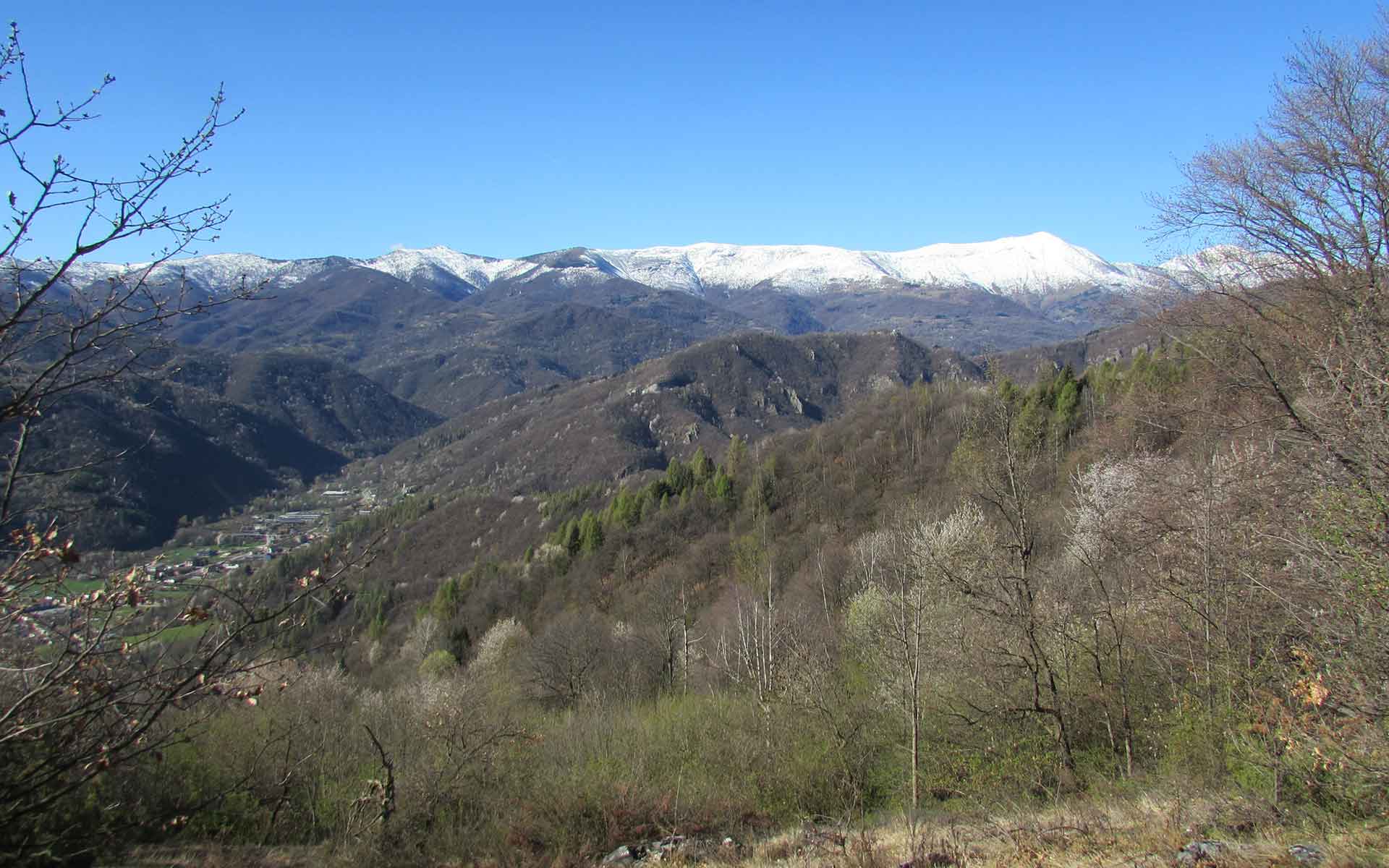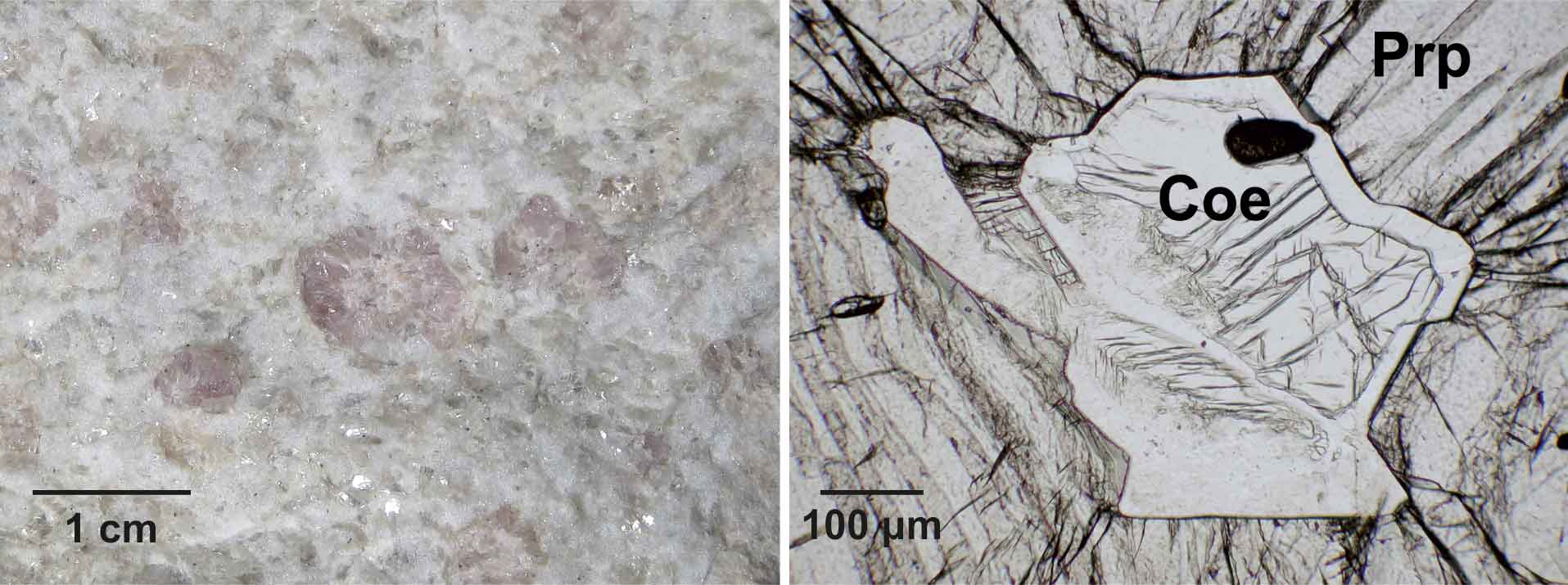
The ultrahigh-pressure metamorphic Brossasco-Isasca Unit (middle and foreground) overlain by lower-grade units of the southern Dora-Maira Massif (background). View towards SW and Brossasco, Varaita valley.
Geological Period
Eocene
Main geological interest
Igneous and Metamorphic petrology
Mineralogy
Location
Cuneo, Piedmont, Western Alps, Italy
44°36’25”N, 007°20’40”E
The ultrahigh-pressure metamorphic Brossasco-Isasca Unit (middle and foreground) overlain by lower-grade units of the southern Dora-Maira Massif (background). View towards SW and Brossasco, Varaita valley.
The first place where ultrahigh-pressure (UHP) metamorphic rocks were described on Earth and recognised as forming a coherent unit.
The discovery of coesite in the DMM, in metamorphic rocks (Chopin, 1984) later shown to form a coherent UHP unit (Chopin et al., 1991; Compagnoni et al., 2012), documented for the first time that continental crust can be subducted to mantle depths, revolutionizing the role imparted to continental crust in geodynamics and the relevant exhumation rates. The term UHP metamorphism was coined; about 40 years later, some 25 further UHP terranes are known on Earth, some of which even contain metamorphic diamond. This first UHP terrane remains unique for the composition of pure pyrope garnet and as sole ellenbergerite locality.
- Geological description
The Dora-Maira Massif (DMM) is one of the internal crystalline massifs of the Western Alps; it was part of the margin of the European continent before its collision with the Adria microcontinent during the Oligocene, after the opening of an intervening ocean during the Mesozoic and its subduction during the Paleocene. Below eclogite-facies remnants of this oceanic crust – the Monviso meta-ophiolite, the DMM exposes a pile of slivers of upper continental crust that reached different metamorphic grades during the Eocene. In the southern part of the massif, one of these slivers, the Brossasco-Isasca Unit, is less than one-kilometer thick and consists of Permian granite and its country-rocks (metapelite and minor marble). The whole unit underwent an Alpine UHP metamorphism epitomized by the occurrence of coesite, a high-pressure polymorph of quartz, in various rock-types and by the presence of near-end member pyrope garnet (Py99) in ‘whiteschist’, a highly magnesian coesite - pyrope - kyanite - white mica +/- talc metasomatic rock occurring as lenses within metagranite. The stability of the kyanite-jadeite assemblage and the presence of the silicate ellenbergerite as inclusions in pyrope megacrysts (up to 25 cm, Schertl et al., 1991) are additional features attesting peak metamorphic pressures exceeding 3 GPa (i.e. = 100 km depth) at temperatures near 700-750°C.As “type locality” for UHP metamorphic rocks and terranes, the Dora-Maira Massif has been continuously attracting new studies: mineralogical (six new phases), petrological (benchmarking of new barometers), geochemical (Mg-metasomatism) or geochronological (continental subduction rate, peak metamorphism, very rapid exhumation), e.g. Gebauer et al. (1997); Rubatto and Hermann (2001).
- Scientific research and tradition
As “type locality” for UHP metamorphic rocks and terranes, the Dora-Maira Massif has been continuously attracting new studies: mineralogical (six new phases), petrological (benchmarking of new barometers), geochemical (Mg-metasomatism) or geochronological (continental subduction rate, peak metamorphism, very rapid exhumation), e.g. Gebauer et al. (1997); Rubatto and Hermann (2001).
- Reference
Chopin, C. (1984) ‘Coesite and pure pyrope in high-grade blueschists of the Western Alps: a first record and some consequences’, Contributions to Mineralogy and Petrology, 86(2), pp. 107–118. Available at: https://doi.org/10.1007/BF00381838.
Chopin, C., Henry, C. and Michard, A. (1991) ‘Geology and petrology of the coesite-bearing terrain, Dora Maira massif, Western Alps.’, European Journal of Mineralogy, pp. 263–292. Available at: https://doi.org/10.1127/ejm/3/2/0263.
Compagnoni, R. et al. (2012) ‘Geological map of the ultra-high pressure Brossasco-Isasca unit (Western Alps, Italy)’, Journal of Maps, 8(4), pp. 465–472. Available at: https://doi.org/10.1080/17445647.2012.744367.
Gebauer, D. et al. (1997) ‘35 Ma old ultrahigh-pressure metamorphism and evidence for very rapid exhumation in the Dora Maira Massif, Western Alps’, Lithos, 41(1), pp. 5–24. Available at: https://doi.org/10.1016/S0024-4937(97)82002-6.
Rubatto, D. and Hermann, J. (2001) ‘Exhumation as fast as subduction?’, Geology, 29(1), pp. 3–6. Available at: https://doi.org/10.1130/0091-7613(2001)029<0003:EAFAS>2.0.CO;2.
Schertl, H.-P., Schreyer, W. and Chopin, C. (1991) ‘The pyrope-coesite rocks and their country rocks at Parigi, Dora Maira Massif, Western Alps: detailed petrography, mineral chemistry and PT-path’, Contributions to Mineralogy and Petrology, 108, pp. 1–21. Available at: https://doi.org/10.1007/BF00307322.
- Author(s)
Hans-Peter Schertl.
Ruhr-University Bochum, Germany.
Christian Chopin.
Ecole Normale Supérieure de Paris – CNRS -PSL, France.


